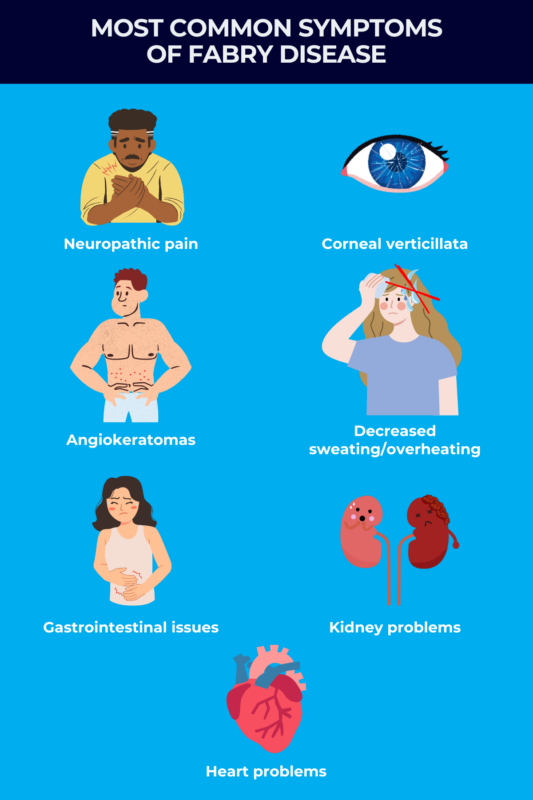
Symptoms of Fabry disease
Last updated July 9, 2024, by Lindsey Shapiro, PHD

Fabry disease is a rare inherited condition characterized by a gradual and progressive onset of debilitating symptoms, including pain in the hands and feet, skin lesions, and more severe complications such as kidney failure and heart disease.
Its symptoms are caused by fatty molecules, especially globotriaosylceramide (Gb3), accumulating in tissues due to genetic mutations in the GLA gene. Mutations in this gene affect the production of an enzyme called alpha-galactosidase A (alpha-Gal A) that’s needed to break those fatty molecules down.
Because this buildup can affect virtually any organ and tissue, there is a wide range of Fabry disease signs and symptoms that a person may have, including ones related to problems with the skin, eyes, nervous system, kidneys, heart, lungs, and gastrointestinal tract.
Each person with Fabry experiences the disease differently, and the pattern of symptoms and affected organs can vary substantially by disease type, sex, and individual. For some, symptoms emerge in childhood or adolescence, but others won’t see any signs of Fabry until adulthood.
As Gb3 levels rise over time, Fabry symptoms often worsen gradually, leading to potential life-threatening complications such as kidney and heart failure or stroke. A prompt diagnosis and initiating a Fabry disease treatment can help delay or prevent these more serious manifestations from developing.

Common symptoms
People with Fabry disease can experience a wide range of disease manifestations, and no two patients will have the exact same set of symptoms.
The most common symptoms of Fabry in childhood and adolescence include pain, gastrointestinal issues, skin rash, eye changes, and problems sweating. In adulthood, along with the aforementioned symptoms, involvement of major organs such as the kidneys, heart, and nervous system, become prevalent.
Neuropathic pain
Pain is one of the earliest and most common symptoms of Fabry disease, reported in up to around two-thirds of patients.
The symptom most commonly manifests as a burning sensation or episodes of numbness, tingling, or discomfort —also known as acroparesthesias — that starts in the hands and feet but may radiate to the arms and legs. This is a type of neuropathic pain, or pain due to nerve damage. It commonly emerges during childhood and adolescence and may be the first symptom that brings patients to the doctor.
Very severe and incapacitating episodes of intense and burning pain may be referred to as a Fabry crisis. Lasting hours to several days, these episodes may be accompanied by body aches, fever, or fatigue and require a visit to the hospital if severe enough.
Pain in Fabry disease is commonly brought on or worsened by heat, stress, exercise, fatigue, or illness, but some patients experience persistent moderate pain even without specific triggers.
Face and eye abnormalities
Around three-quarters of Fabry disease patients experience corneal verticillata, that is, a starburst-like pattern of opaque (cloudy) areas on the surface layer of the eye due to Gb3 buildup. This corneal opacity does not typically cause vision problems and can only be identified by a doctor during an eye exam.
While there can be other causes of cloudiness in the eye, corneal verticillata is most often associated with Fabry disease and thus can help doctors make a Fabry diagnosis. If an eye doctor notices this symptom, a person should be tested for Fabry disease.
Other eye-related symptoms that may occur in Fabry disease include:
- tortuous, or twisted, blood vessels in the eyes
- opacities in the eyes’ lens (cataracts)
- atrophy of the optic nerve.
Fabry disease can also lead to distinct facial features, including fullness around the eye sockets, called periorbital fullness, pronounced nose and ear lobules, recessed forehead, prominent brow bone (supraorbital ridge), bushy eyebrows, and full lips.
Skin issues
An easily identifiable and very common symptom of Fabry disease is the emergence of a skin rash called angiokeratoma, characterized by clusters of small, dark red spots on the skin. These occur due to the spread of dilated blood vessels in the skin and can be described as hard and almost wart-like.
Angiokeratomas are often found between the navel and the knees, but may also be observed more diffusely in places such as the lips, hands, toes, or genitals. They are noncancerous and usually are not painful, but can bleed or hurt if they’re scratched or disturbed excessively. Often first observed in childhood or adolescence, angiokeratomas may become larger and more numerous with age.
Hyperkeratosis, or thickening of the outermost layer of the skin, is also frequently seen in those with Fabry disease. This can lead to rough, dry, and scaly patches on the skin, often appearing on the hands, feet, and knees.
Heat intolerance and sweating issues
Fabry patients often sweat less than normal or not at all, conditions known as hypohidrosis and anhidrosis, respectively. This occurs as a result of damage to the sweat glands and nerves involved in autonomic body functions, or unconscious body tasks.
Sweating issues are often one of the early signs of Fabry disease that emerge in childhood. Excessive sweating, or hyperhidrosis, can also occur in some patients, but not has been reported as often.
Decreased sweating can cause Fabry patients to become easily overheated and have fevers. They also tend to be intolerant to weather extremes, both hot and cold. These symptoms can make it more difficult for patients to exert themselves or exercise without becoming overheated, and exercise intolerance is commonly observed.
Gastrointestinal issues
Gastrointestinal problems are a common complaint in Fabry disease, affecting about two-thirds of patients. Symptoms may include:
- diarrhea
- abdominal pain
- mucosal lesions
- intestinal malabsorption
- early feelings of fullness during eating, or bloating and discomfort after eating.
In some cases, symptoms may cause patients to have a reduced appetite or to avoid food, leading to weight loss.
While gastrointestinal problems are often among the earliest symptoms a patient has, they may go unrecognized because they are nonspecific and can overlap with a range of other serious and non-serious conditions.
Kidney impairment
For most patients, Fabry disease eventually affects the kidneys. This may start as only mild kidney impairment, but tends to progressively worsen over time and can eventually lead to complete kidney failure.
For some patients with adult-onset symptoms, kidney impairments might be the first manifestation of the disease.
While signs of kidney disease may not be obvious at first, a doctor might detect signs of protein or albumin in the urine or other indicators of kidney problems in lab tests.
Later in the disease course, symptoms of kidney failure may include:
- changes in urinary frequency
- appetite changes
- dry, itchy skin
- swollen legs and feet
- muscle cramps.
Heart disease
Cardiac involvement in Fabry disease is common, as the accumulation of Gb3 in heart tissues results in a high likelihood of heart problems.
As with kidney problems, these issues tend to progress over time, leading to worsening damage to the heart and the blood vessels that supply it.
Cardiac problems that can happen in Fabry include:
- left ventricular hypertrophy, in which the heart muscle’s left ventricle, which pumps oxygenated blood out to the body, becomes thickened and enlarged, making the heart work harder to pump blood
- malfunctioning heart valves
- high blood pressure
- arrhythmias, or abnormal heart rhythms
- heart failure, when the heart doesn’t pump blood as well as it should
- heart attack.
Other potential symptoms
A range of other symptoms may also arise throughout the course of Fabry disease. These may include:
- ringing in the ears (tinnitus) and hearing loss
- neurological symptoms other than pain, including dizziness, headaches, weakness, or disturbed concentration
- breathing issues, including shortness of breath or airway obstruction, that may be associated with heart damage
- joint pain and inflammation
- sparse hair growth
- lymphedema, or tissue swelling due to poor drainage of lymph fluid, a part of the immune system
- anemia, or a low number of red blood cells or of the hemoglobin protein that carries oxygen in those cells
- anorexia, or loss of appetite
- chronic fatigue
- delayed puberty
- behavioral issues and cognitive impairment.
Complications of Fabry disease
In the absence of treatment, a person with Fabry disease will experience a substantial accumulation of Gb3 in vital organs such as the heart, kidneys, and nervous system. This can lead to serious and life-threatening complications, including stroke and organ failure.
Stroke
The storage of Gb3 in blood vessel walls can cause a stroke, a medical emergency that occurs when there is not enough blood supply to the brain either because blood vessels are blocked or ruptured. This can cause lasting brain damage and may be fatal in some cases.
Receiving treatment as soon as possible after having a stroke is critical to increase the chances of recovering without disability, so patients should be aware of warning signs of stroke, which may include:
- sudden numbness or weakness on one side of the body
- confusion
- difficulty speaking or slurred or garbled speech
- blurred or double vision
- sudden and severe headache with no known cause.
Kidney or heart failure
When heart damage progresses to the point where the heart can no longer pump blood efficiently, a person with Fabry may have heart failure. This is a leading cause of death in Fabry disease. Symptoms of heart failure may include:
-
- shortness of breath
- persistent cough or wheezing
- fluid retention and swelling
- fatigue
- increased heart rate
- loss of appetite.
The gradual deterioration of kidney function in Fabry disease can also result in kidney failure, a life-threatening condition where the kidneys are unable to filter waste products from the blood effectively.
Kidney failure is one of the leading causes of mortality in Fabry patients. When it occurs, interventions such as kidney transplant or dialysis may become necessary to maintain adequate blood filtration and increase life expectancy for people with Fabry.
Classic vs. late onset
Fabry disease can be broadly categorized into types — classic and late-onset — that can generally be differentiated by the residual levels of alpha-Gal A enzyme activity.
In classic Fabry disease, marked by little to no alpha-Gal A activity, symptoms usually become evident in early childhood or adolescence. Among the first observable symptoms are acroparesthesias, angiokeratomas, insufficient sweating, gastrointestinal problems, and corneal verticillata. As patients with classic Fabry age, they’ll typically start to see involvement of the major organs, including the heart, kidneys, and vascular system, that progressively worsens.
Late-onset Fabry disease symptoms don’t usually emerge until adulthood due to the presence of some residual alpha-Gal A enzyme activity. Many of these patients won’t have the earliest signs that are seen in classic Fabry disease, but will instead present with involvement of a single major organ, such as the kidneys or heart, in middle age.
Do Fabry symptoms differ between men and women?
Fabry disease is an X-linked genetic disorder, which means the mutations associated with it are located within the X chromosome, one of the sex chromosomes.
Given the underlying cause of Fabry disease and how it is inherited, Fabry was long considered to affect only men. This is because males have only one X chromosome, and thus a mutation in their GLA gene results in a deficiency of a functional alpha-Gal A enzyme. Conversely, females have two X chromosomes, and even if one GLA copy is mutated, they will typically have a normal GLA gene copy in the other chromosome that can provide some protection from the disease.
It’s now recognized that both men and women carrying a Fabry disease-causing mutation can have Fabry disease symptoms, but there are some differences in the way the condition manifests in both sexes.
While symptoms in men tend to follow a more standard course, they can vary substantially in women, who may be entirely asymptomatic or have symptoms as severe as their male counterparts.
Still, Fabry disease symptoms in females are typically more subtle, occur later in life, and progress slower than they do in men. As such, it may not be as easy to diagnose the disease in women. On average female patients don’t receive a Fabry disease diagnosis until more than a decade after their symptoms appear.
Data from the international Fabry Registry suggest that heart disease is the most common serious manifestation of Fabry disease experienced by women, occurring almost as often as in men, but typically emerging later in life. Women in that registry also saw fewer kidney problems than men, although they were more likely to have a mini-stroke. Severe nerve pain may also be more common in women.
Fabry Disease News is strictly a news and information website about the disease. It does not provide medical advice, diagnosis or treatment. This content is not intended to be a substitute for professional medical advice, diagnosis, or treatment. Always seek the advice of your physician or other qualified health provider with any questions you may have regarding a medical condition. Never disregard professional medical advice or delay in seeking it because of something you have read on this website.
Recent Posts
- Canada approves ERT Elfabrio for adults with Fabry disease
- I work hard to influence my health outcome with Fabry disease
- Canadian study highlights stroke danger for young adults with Fabry
- Fabry treatment ST-920 boosts kidney, heart function in trial
- Echocardiograms may spot early heart disease in Fabry, study finds
- In rare case, woman diagnosed with both Fabry and blood disorder
- Companies challenge EMA advice rejecting monthly Elfabrio dosing
- ERT may protect heart function after Fabry kidney failure
- Helping my children with Fabry find ways to combat depression
- EU agency urges against monthly dosing plan for Fabry drug Elfabrio




